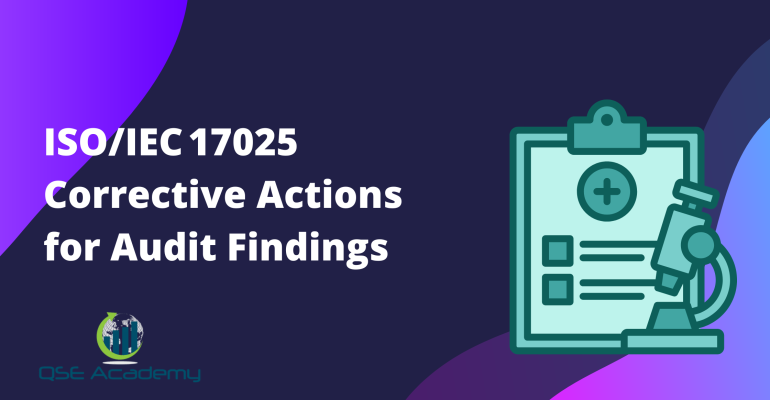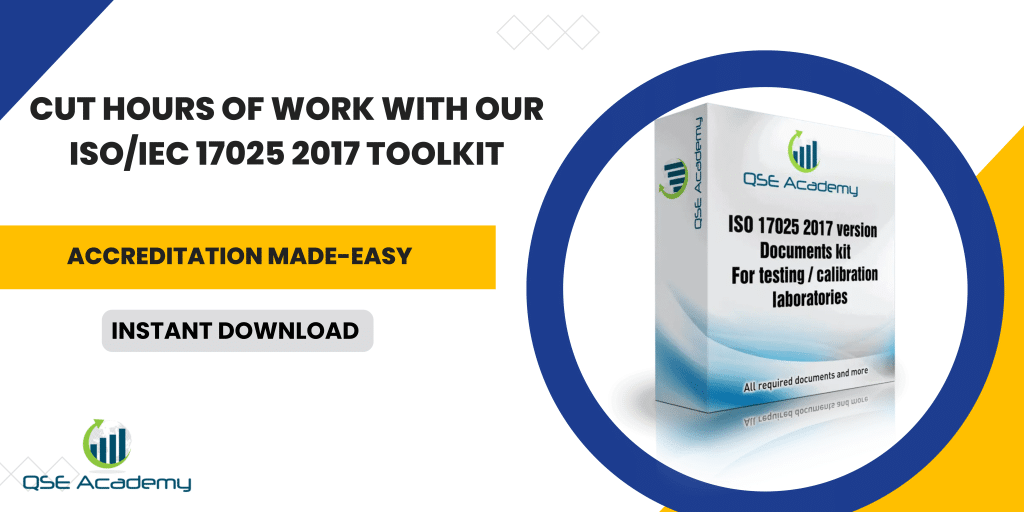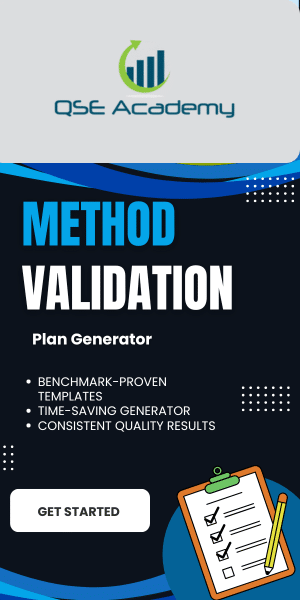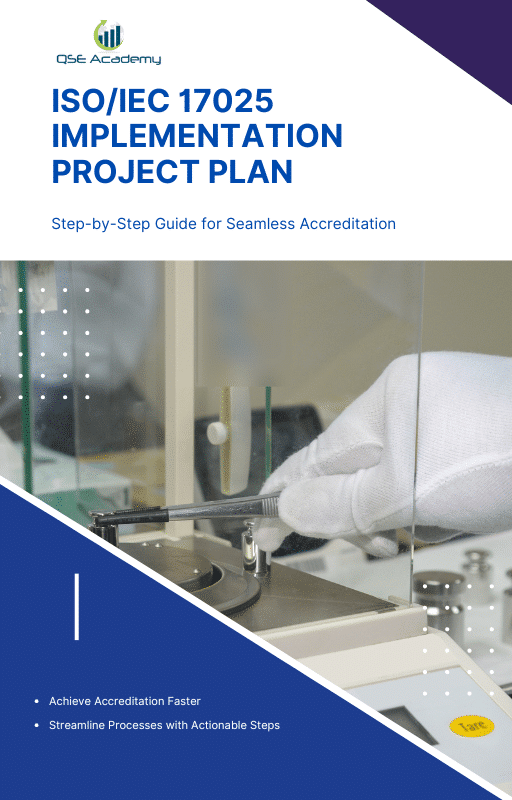ISO/IEC 17025 Corrective Actions for Audit Findings
Last Updated on October 13, 2025 by Melissa Lazaro
Turning Audit Findings into Opportunities for Improvement
If you’ve ever stared at an audit report filled with findings and thought, “Where do we even start?” — you’re not alone.
Every lab, no matter how competent, faces nonconformities during ISO/IEC 17025 assessments. The real difference between an overwhelmed lab and a confident one lies in how they respond.
Here’s what I’ve seen over and over: labs that treat corrective actions as paperwork struggle to keep compliance stable. Labs that treat them as learning opportunities end up with stronger systems — and happier assessors.
Corrective actions aren’t punishments. They’re the standard’s way of asking:
“Do you understand why this happened, and can you prove it won’t happen again?”
In this guide, I’ll walk you through how to:
-
Interpret what ISO/IEC 17025 actually requires in Clause 8.7.
-
Respond to findings step-by-step — from root cause to verification.
-
Avoid common mistakes that make responses look weak.
-
And most importantly, turn corrective actions into evidence of real improvement.
Because when you handle findings the right way, your lab doesn’t just pass the audit — it gets better every time.
What ISO/IEC 17025 Requires for Corrective Actions (Clause 8.7 Explained)
Here’s something I tell every lab manager after an audit: Clause 8.7 isn’t about fixing mistakes — it’s about proving you understand them.
ISO/IEC 17025 expects more than a quick patch; it wants a thoughtful, traceable process that prevents the same issue from coming back.
Let’s break it down in plain language.
What Clause 8.7 Actually Says
Whenever a nonconformity occurs — during an audit, in daily work, or through a complaint — your lab must:
-
React to the nonconformity and control it (contain the problem).
-
Evaluate its impact on results or validity of previous work.
-
Determine the root cause.
-
Implement corrective action to remove that cause.
-
Review the effectiveness of what you did.
That’s it. It’s a cycle of logic, not bureaucracy.
Example:
If an expired calibration certificate is found, don’t just recalibrate and move on.
Ask why it expired: no reminder system? lack of staff awareness? system access issue?
Your corrective action should fix the cause, not the symptom.
Correction vs. Corrective Action
Labs often mix these up — and assessors notice.
-
Correction fixes the immediate problem.
“We recalibrated the instrument.”
-
Corrective Action fixes the reason it happened.
“We implemented a calibration reminder system and trained staff on tracking procedures.”
Pro Tip: Your assessor doesn’t expect miracles. They expect traceability — a logical flow from finding → cause → fix → proof.
Why Clause 8.7 Matters
This requirement shows assessors that your lab isn’t just reactive — it’s capable of self-diagnosis.
When you demonstrate solid corrective-action control, it tells accreditation bodies your quality system is alive and improving, not frozen in compliance mode.
Step-by-Step: How to Respond to an ISO/IEC 17025 Audit Finding
When an audit finding lands on your desk, the instinct is to fix it fast — to make it disappear. But here’s what I’ve learned after years of helping labs respond to accreditation audits: speed doesn’t impress assessors — clarity does.
A strong corrective action response doesn’t just close a finding; it tells a story — one that shows you understood the issue, addressed it systemically, and verified that it won’t happen again.
Let’s go through that story, step by step.
Step 1: Understand and Classify the Finding
Start by reading the audit finding carefully. Don’t jump straight to fixing it.
Ask yourself:
-
What exactly went wrong?
-
Which ISO/IEC 17025 clause does it relate to?
-
Is it a major issue (systemic impact) or minor (isolated incident)?
If something’s unclear, reach out to the assessor or your accreditation coordinator. Getting the context right avoids wasted effort later.
Pro Tip: Never assume what the assessor meant — clarify early, respond confidently later.
Step 2: Investigate and Identify the Root Cause
This is where most labs stumble. They describe the problem, not the cause.
Here’s the difference:
-
Problem: “Equipment was used past calibration date.”
-
Root Cause: “There was no automated reminder or review system for calibration schedules.”
Use simple tools like the 5 Whys or a Fishbone Diagram to dig deeper. Keep asking “why” until you hit the process failure, not just the human error.
Example:
Finding: “Missing training record.”
→ Why? The training was completed but not logged.
→ Why? The supervisor didn’t know logging was required.
→ Why? The SOP didn’t clearly assign that responsibility.
Root Cause: Incomplete procedure definition, not just a missed signature.
Step 3: Define Corrective Actions That Fix the System, Not the Symptom
Your goal isn’t to fix one event — it’s to make sure the same type of issue never happens again.
Once you know the root cause, design a system-level solution.
Weak action: “Remind staff to complete training logs.”
Strong action: “Revise SOP to clarify responsibility for logging, train all supervisors, and add a quarterly compliance check.”
The second one solves the process weakness.
Pro Tip: If your corrective action doesn’t change a system (a form, a process, a checklist, a training plan), it’s not really corrective.
Step 4: Document Clearly and Log Everything
Record your findings in a corrective action register or form that includes:
-
The finding and related clause.
-
The root cause.
-
The corrective action(s) taken.
-
The responsible person and completion date.
Attach proof — screenshots, updated procedures, training records — anything that shows the fix exists and works.
Pro Tip: Use clause references (e.g., 6.4.6 for calibration records). It helps assessors follow your logic and reinforces your system knowledge.
Step 5: Verify the Effectiveness of the Action
This is the most overlooked step — and the one assessors care about most.
You must show that your fix worked and stayed consistent over time.
Examples of verification evidence:
-
Recent calibration logs show all equipment in date.
-
Training matrix now 100% complete and up to date.
-
Internal audit confirms new procedure is being followed.
Verification proves your system isn’t just reactive — it’s self-correcting.
Pro Insight:
A strong corrective-action response should read like a cause-and-effect chain:
“We found this… because this caused it… so we changed this… and here’s proof it worked.”
If your report follows that logic, you’ll earn respect from assessors — and more importantly, you’ll build a lab that improves continuously.
Common Mistakes Labs Make When Handling Corrective Actions
Even the best labs trip up here. Not because they don’t care — but because in the rush to “close the finding,” they miss what corrective actions are really for: systemic improvement.
I’ve reviewed hundreds of audit responses, and the same mistakes appear again and again. Let’s unpack the big ones so you can avoid them.
1. Rushing the Response
When you’re eager to get findings off your plate, it’s tempting to fire off a quick reply:
“Staff retrained. Problem solved.”
But that’s not a corrective action — it’s a bandage.
Rushed responses usually skip the root-cause analysis, which means the issue quietly repeats later.
Fix: Slow down just enough to investigate properly. Assessors would rather see a thoughtful, delayed response than a fast, shallow one.
Pro Tip: Write your response draft, then ask, “Does this address why it happened or just what happened?”
2. Blaming “Human Error” as the Root Cause
This one’s everywhere. Labs love to write:
“Root cause: human error.”
The problem? It’s almost never true.
People make mistakes because systems allow them to. If someone forgot to calibrate equipment, ask why the system didn’t catch it.
Better Root Cause Example:
“Calibration oversight occurred because the reminder system relies on manual tracking with no verification step.”
Fix: Redesign processes, not people. Automation, clear checklists, and defined responsibilities prevent human error from being your go-to excuse.
3. Fixing the Symptom, Not the System
Here’s the pattern: the lab fixes the specific issue — updates one record, recalibrates one instrument — and calls it done.
Then the next audit reveals the same problem in a different area.
Example:
The lab re-trained one technician who missed a test procedure step, but didn’t review if the procedure itself was confusing.
Fix: After every finding, ask:
“What process allowed this to happen, and how can we make it impossible to repeat?”
Systemic thinking turns temporary fixes into permanent improvements.
4. Delaying Verification
Many labs do the hard work — then forget to check if it actually worked.
They mark the corrective action as “closed” without reviewing evidence.
During the next audit, the assessor will ask:
“How did you verify this change is effective?”
And silence is never a good look.
Fix: Schedule verification 30–60 days after implementation.
Check records, interview staff, or review updated logs. Document the verification results clearly.
5. Copy-Pasting Generic Corrective Actions
Auditors can spot boilerplate language instantly.
When every finding response says, “Staff retrained and SOP updated,” it signals your team is reacting mechanically, not thinking critically.
Fix: Personalize each corrective action to the process. Use evidence and examples specific to your lab. Authenticity shows maturity.
6. Treating Corrective Actions as a Quality-Only Task
Here’s the big one: labs often leave corrective actions to the quality manager alone.
That’s a missed opportunity.
When the process owners — technicians, supervisors, analysts — participate, the fixes are more accurate and sustainable.
Fix: Make corrective actions a shared responsibility. Quality oversees the process, but operations must own the change.
Pro Tip: Involve the person closest to the process in the root-cause analysis. They often know the “real why” faster than anyone else.
Tools and Templates for Effective Corrective Actions
If there’s one thing I’ve learned after working with hundreds of labs, it’s this: great corrective actions don’t depend on complex software or fancy jargon. They depend on clarity, consistency, and traceability.
The right tools help you achieve all three. You don’t need to overcomplicate it — a few simple, well-structured templates can turn chaos into control.
Here’s what every ISO/IEC 17025 lab should have in its corrective-action toolkit.
1. Corrective Action Register (Your Master Tracker)
Think of this as your command center. It’s where you log every finding from audits, complaints, or incidents and track them to closure.
What it should include:
| Field | Description |
|---|---|
| Finding Reference | The audit or clause reference |
| Description of Nonconformity | What went wrong |
| Root Cause | Why it happened |
| Corrective Action | What was done to fix the cause |
| Responsible Person | Who owns the fix |
| Due Date | Target completion date |
| Verification Date & Result | Proof that the action worked |
Pro Tip: Color-code your register — red (open), yellow (in progress), green (closed). It’s simple, visual, and keeps accountability front and center.
2. Root-Cause Analysis Worksheet
Most weak corrective actions come from poor root-cause analysis.
This worksheet keeps the investigation structured and consistent.
Include tools like:
-
5 Whys: Keep asking “why” until you reach the true system cause.
-
Fishbone Diagram (Ishikawa): Helps visualize potential causes under categories like Methods, Equipment, People, Environment, and Materials.
Example:
Finding: “Incomplete environmental monitoring records.”
Root cause (after 5 Whys): “No defined schedule or assigned responsibility for daily readings.”
Corrective action: “Add daily reminder, assign operator, review logs weekly.”
3. Corrective Action Form (For Individual Findings)
Every nonconformity deserves its own paper trail — especially for accreditation submissions.
Suggested layout:
-
Reference: Audit number and ISO clause.
-
Description: Summary of finding.
-
Root Cause: Results of investigation.
-
Corrective Action: Steps implemented to address root cause.
-
Verification: Evidence that action is effective (with attachments).
-
Approval: Sign-off by quality and management.
Pro Tip: Keep it simple and one page long. Assessors prefer clarity over complexity.
4. Verification Checklist
This checklist keeps your “effectiveness review” objective and consistent.
Ask:
-
Has the same issue reoccurred?
-
Are updated records consistent and compliant?
-
Were relevant staff trained and aware of changes?
-
Has the change improved performance or reduced risk?
If you can answer yes to all, your action is genuinely closed.
5. Evidence Tracker (Optional but Powerful)
Attach supporting proof — updated SOPs, training records, calibration certificates, screenshots, meeting minutes.
Having all evidence linked in one folder saves hours during re-assessment.
Pro Tip: Use filenames like “CA_2025-03_Clause7.6_Verification.pdf.” Assessors appreciate clean organization.
A Quick Example in Practice
Let’s say you had a finding about outdated SOPs.
-
You log it in your Corrective Action Register.
-
Use the Root-Cause Worksheet to determine the cause: document-control system lacked version review alerts.
-
On your Corrective Action Form, you describe how you added automatic notifications and retrained staff.
-
Thirty days later, your Verification Checklist shows all SOPs current and reviewed.
That’s a textbook example of a clean, traceable corrective-action process.
Real-World Example – Closing the Loop Correctly
Sometimes the best way to understand corrective actions is to see how they work in real life.
Let me share one example that stuck with me — because it perfectly illustrates the difference between “fixing the issue” and fixing the system.
The Scenario: A Calibration Lab With Recurring Equipment Findings
A mid-sized calibration lab I supported kept getting the same finding during every audit:
“Equipment used past calibration due date.”
Each time, they responded quickly: recalibrated the instrument, filed the certificate, and moved on.
But the same problem resurfaced year after year.
The lab was frustrated. The assessors were frustrated. And on the third audit, it escalated from a minor to a major nonconformity.
That’s when they called me in.
Step 1: The Investigation
We started by mapping out the process for how calibration due dates were tracked.
Turns out, it was entirely manual — one Excel sheet on a shared drive that only one technician updated. When that technician was on leave, updates simply… didn’t happen.
So the real problem wasn’t the equipment.
It was a weak system with no accountability and no backup.
Step 2: The Root Cause
We applied the 5 Whys method:
-
Why was the equipment overdue? → No reminder sent.
-
Why was there no reminder? → The spreadsheet wasn’t updated.
-
Why wasn’t it updated? → Technician was away.
-
Why was no one else updating it? → No one assigned as backup.
-
Why was there no backup? → No documented process or ownership for calibration tracking.
Root cause: Lack of defined responsibility and system redundancy for calibration scheduling.
Step 3: The Corrective Action
The lab decided to implement a cloud-based equipment tracking tool with automated email reminders 30 days before calibration was due.
They also revised their procedure to assign both a primary and secondary person for review.
Finally, they trained the team on the new system and documented everything.
Step 4: The Verification
Thirty days later, during an internal audit, we checked the logs.
Every instrument showed valid calibration.
Three reminders had already been triggered automatically.
The assessor during the next surveillance audit even commented:
“This is one of the most efficient equipment tracking systems I’ve seen.”
The Result
What started as a recurring weakness turned into a showcase of improvement.
Not only did the lab eliminate repeat findings — they built a system that saved hours of manual tracking and impressed their accreditation body.
That’s what closing the loop correctly looks like.
It’s not about fixing one problem — it’s about strengthening the whole process so that the same problem can’t happen again.
Pro Tip: Assessors respect labs that learn. When they see evidence of genuine process improvement — not just compliance — your audit tone shifts from inspection to collaboration.
Best Practices to Prevent Future Non-Conformities
Once your corrective actions are in place and verified, the next goal is simple — don’t let the same problems return.
The truth is, preventing non-conformities isn’t about luck or chasing compliance; it’s about building a lab culture that spots risks early and treats improvement as an everyday habit.
Here’s how the most audit-ready labs keep their systems strong between assessments.
1. Feed Findings into Your Management Review
Your management review is where information becomes insight.
Every audit finding, corrective action, and near miss should feed into it — not as a formality, but as part of your lab’s strategic discussion.
Ask during review meetings:
-
Are there recurring findings across audits?
-
Which processes show the most risk or variability?
-
What changes actually improved performance this year?
Pro Tip: Use visuals. A simple bar chart showing which clauses produce the most nonconformities gives management a quick, actionable snapshot of where to focus next.
2. Hold Post-Audit Learning Sessions
Don’t just fix findings — share the lessons.
After every audit, gather your team for a short debrief. Discuss what went well, what surprised you, and what needs attention.
I’ve seen this one step completely change team morale. It turns audits from “something done to us” into “something learned from.”
And when staff understand why a finding happened, they naturally start preventing the next one.
3. Review Corrective-Action Trends Quarterly
Your corrective-action register isn’t just for tracking closure dates. It’s a data goldmine.
Review it every quarter and look for trends:
-
Are multiple findings linked to training?
-
Do similar issues appear in different departments?
-
Are the same root causes popping up in different forms?
Example:
One lab realized that half their findings related to unclear SOPs.
Instead of chasing individual issues, they ran a project to simplify all technical procedures — and their next audit had zero documentation-related findings.
4. Encourage Staff to Report Near Misses
Most non-conformities start as small, unnoticed errors. When staff feel safe to speak up early, you can fix issues long before they reach audit level.
Pro Tip: Create a simple “Quality Observation Log” — one page where anyone can record a potential risk or improvement idea. Review it monthly.
It costs almost nothing but builds a mindset of accountability and openness.
5. Keep Your Internal Audit Program Alive
Internal audits shouldn’t feel like a chore or an afterthought. Done right, they’re the best prevention tool you have.
Rotate auditors, use fresh checklists, and include technical questions — not just document checks.
A good internal audit will reveal weaknesses before the assessor ever can.
Example:
A small environmental lab started alternating internal auditors from different sections.
Fresh eyes caught overlooked trends, and repeat findings disappeared in one cycle.
6. Celebrate Improvement
It sounds simple, but it matters. When your team closes findings or achieves zero nonconformities, acknowledge it.
Recognition reinforces engagement — and engaged teams naturally protect the system they helped strengthen.
Bottom Line:
Prevention isn’t about adding more checklists. It’s about connecting people, data, and processes so your system keeps improving on its own.
That’s what a mature ISO/IEC 17025 laboratory looks like — proactive, confident, and always learning.
FAQs – Corrective Actions in ISO/IEC 17025 Audits
Over the years, I’ve noticed the same few questions pop up right after every audit debrief.
So, if you’ve ever wondered how to manage your corrective actions without second-guessing yourself, here are straightforward answers to the ones labs ask most.
Q1. How long do we have to close corrective actions after an audit?
Most accreditation bodies give 30 to 90 days to submit your corrective-action plan and supporting evidence.
But here’s my advice — don’t wait for the deadline.
Start the investigation immediately while the context is still fresh. Labs that respond within two weeks usually close findings faster because their evidence is clearer and easier to verify.
Pro Tip: Draft your root-cause analysis and action plan as soon as the audit ends — before the final report even arrives.
Q2. What’s the difference between a correction and a corrective action?
This one confuses many teams.
-
Correction fixes the immediate issue.
Example: Recalibrating a balance found overdue.
-
Corrective Action eliminates the reason it went overdue in the first place.
Example: Implementing an automated calibration-reminder system and assigning clear ownership.
Assessors look for both — the quick fix and the system fix.
Q3. Can we update or change our corrective-action plan later?
Absolutely. ISO/IEC 17025 encourages continual improvement, not rigid paperwork.
If your initial plan doesn’t fully solve the issue, document what you learned and adjust the action.
Assessors respect that level of honesty — it shows maturity, not weakness.
Q4. What kind of evidence do assessors expect for verification?
Think tangible proof. They’re not looking for promises; they’re looking for records.
Typical evidence includes:
-
Updated SOPs or controlled forms.
-
Completed training logs.
-
System screenshots showing new processes in use.
-
Internal-audit results verifying the fix.
The key is to show that the change is implemented and sustainable, not theoretical.
Q5. Who should be responsible for corrective actions?
Quality management oversees the process, but process owners should lead the fix.
If the issue occurred in testing, the testing supervisor should drive the response — with QA support, not substitution.
This shared ownership keeps actions practical and ensures the people closest to the work maintain accountability.
Bottom Line:
Corrective actions only feel heavy when they’re misunderstood.
Once you see them as tools for improvement — not administrative punishment — they become one of the most valuable parts of your ISO/IEC 17025 system.
Corrective Action Is Proof of Competence, Not Compliance
Here’s the mindset shift that separates average labs from exceptional ones:
Corrective actions aren’t about satisfying auditors — they’re about proving your lab understands how to learn, adapt, and improve.
In every successful accreditation I’ve supported, one thing stood out.
The labs that treated corrective actions as opportunities, not obligations, always came out stronger — more efficient, more confident, and more respected by assessors.
Let’s Recap the Essentials
-
Clause 8.7 isn’t about fixing mistakes quickly — it’s about fixing them completely.
-
Strong corrective actions start with a solid root-cause analysis and end with a verified, lasting improvement.
-
Weak responses focus on individuals; strong ones strengthen systems.
-
Verification isn’t optional — it’s how you prove your system truly works.
-
Prevention is the final step — turn lessons into everyday improvements so findings don’t repeat.
When you follow that flow — find, fix, verify, improve — you’re not just meeting ISO/IEC 17025 requirements.
You’re showing your lab has what every accreditation body values most: competence backed by evidence.
A Final Thought
Audit findings can sting — but they’re also signals.
Each one points to something you can strengthen, simplify, or streamline.
And when your lab learns to act on those signals with confidence, you don’t just survive audits — you lead them.
I’ve seen labs go from defensive to proactive in a single year just by mastering their corrective-action process.
The difference? They stopped asking, “How fast can we close this?” and started asking, “How do we make sure it never happens again?”
That’s what true continual improvement looks like.
Your Next Step
If your lab is preparing to respond to audit findings — or wants to refine its corrective-action system — we’ve built a practical tool to make it simple:
Download QSE Academy’s ISO/IEC 17025 Corrective-Action Template and Root Cause Analysis Worksheet.
It’s the same structure our consultants use to help labs respond effectively and build lasting compliance.
Or, if you’d rather have expert guidance, book a one-on-one consultation with a QSE Academy ISO/IEC 17025 specialist.
We’ll review your audit report, identify systemic gaps, and help you craft corrective actions that not only satisfy assessors but actually strengthen your lab.
Because in the world of ISO/IEC 17025, compliance is just the starting point — competence is the goal.
I hold a Master’s degree in Quality Management, and I’ve built my career specializing in the ISO/IEC 17000 series standards, including ISO/IEC 17025, ISO 15189, ISO/IEC 17020, and ISO/IEC 17065. My background includes hands-on experience in accreditation preparation, documentation development, and internal auditing for laboratories and certification bodies. I’ve worked closely with teams in testing, calibration, inspection, and medical laboratories, helping them achieve and maintain compliance with international accreditation requirements. I’ve also received professional training in internal audits for ISO/IEC 17025 and ISO 15189, with practical involvement in managing nonconformities, improving quality systems, and aligning operations with standard requirements. At QSE Academy, I contribute technical content that turns complex accreditation standards into practical, step-by-step guidance for labs and assessors around the world. I’m passionate about supporting quality-driven organizations and making the path to accreditation clear, structured, and achievable.












